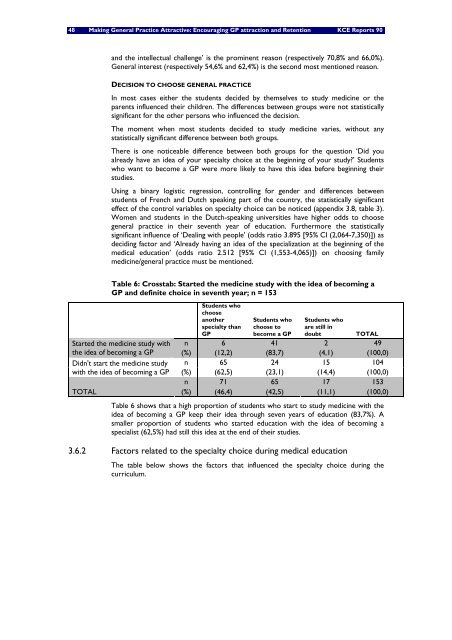Download the report (150 p.) - KCE
Download the report (150 p.) - KCE
Download the report (150 p.) - KCE
You also want an ePaper? Increase the reach of your titles
YUMPU automatically turns print PDFs into web optimized ePapers that Google loves.
48 Making General Practice Attractive: Encouraging GP attraction and Retention <strong>KCE</strong> Reports 90<br />
and <strong>the</strong> intellectual challenge’ is <strong>the</strong> prominent reason (respectively 70,8% and 66,0%).<br />
General interest (respectively 54,6% and 62,4%) is <strong>the</strong> second most mentioned reason.<br />
DECISION TO CHOOSE GENERAL PRACTICE<br />
In most cases ei<strong>the</strong>r <strong>the</strong> students decided by <strong>the</strong>mselves to study medicine or <strong>the</strong><br />
parents influenced <strong>the</strong>ir children. The differences between groups were not statistically<br />
significant for <strong>the</strong> o<strong>the</strong>r persons who influenced <strong>the</strong> decision.<br />
The moment when most students decided to study medicine varies, without any<br />
statistically significant difference between both groups.<br />
There is one noticeable difference between both groups for <strong>the</strong> question ‘Did you<br />
already have an idea of your specialty choice at <strong>the</strong> beginning of your study?’ Students<br />
who want to become a GP were more likely to have this idea before beginning <strong>the</strong>ir<br />
studies.<br />
Using a binary logistic regression, controlling for gender and differences between<br />
students of French and Dutch speaking part of <strong>the</strong> country, <strong>the</strong> statistically significant<br />
effect of <strong>the</strong> control variables on specialty choice can be noticed (appendix 3.8, table 3).<br />
Women and students in <strong>the</strong> Dutch-speaking universities have higher odds to choose<br />
general practice in <strong>the</strong>ir seventh year of education. Fur<strong>the</strong>rmore <strong>the</strong> statistically<br />
significant influence of ‘Dealing with people’ (odds ratio 3.895 [95% CI (2,064-7,350)]) as<br />
deciding factor and ‘Already having an idea of <strong>the</strong> specialization at <strong>the</strong> beginning of <strong>the</strong><br />
medical education’ (odds ratio 2.512 [95% CI (1,553-4,065)]) on choosing family<br />
medicine/general practice must be mentioned.<br />
Table 6: Crosstab: Started <strong>the</strong> medicine study with <strong>the</strong> idea of becoming a<br />
GP and definite choice in seventh year; n = 153<br />
Students who<br />
choose<br />
ano<strong>the</strong>r<br />
specialty than<br />
GP<br />
Students who<br />
choose to<br />
become a GP<br />
Students who<br />
are still in<br />
doubt<br />
TOTAL<br />
Started <strong>the</strong> medicine study with n 6 41 2 49<br />
<strong>the</strong> idea of becoming a GP (%) (12,2) (83,7) (4,1) (100,0)<br />
Didn't start <strong>the</strong> medicine study n 65 24 15 104<br />
with <strong>the</strong> idea of becoming a GP (%) (62,5) (23,1) (14,4) (100,0)<br />
n 71 65 17 153<br />
TOTAL (%) (46,4) (42,5) (11,1) (100,0)<br />
Table 6 shows that a high proportion of students who start to study medicine with <strong>the</strong><br />
idea of becoming a GP keep <strong>the</strong>ir idea through seven years of education (83,7%). A<br />
smaller proportion of students who started education with <strong>the</strong> idea of becoming a<br />
specialist (62,5%) had still this idea at <strong>the</strong> end of <strong>the</strong>ir studies.<br />
3.6.2 Factors related to <strong>the</strong> specialty choice during medical education<br />
The table below shows <strong>the</strong> factors that influenced <strong>the</strong> specialty choice during <strong>the</strong><br />
curriculum.
















